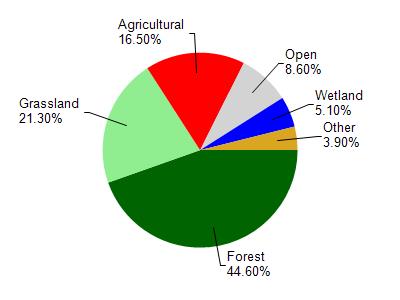Vernon
Yes
No
No
Fish and Aquatic Life
Overview
Lindahl Creek, also known as Hagen Creek or Dodson Hollow Creek, is located in northwestern Vernon County. It flows in a westerly direction for approximately three miles before reaching Coon Creek east of Chaseburg. This stream has a moderately steep gradient of 53 feet per mile and drains steep wooded hillsides and agricultural land. Lindahl Creek is a Class I trout stream for its entire length.
Date 2011
Author Cynthia Koperski
Historical Description
Lindahl (Dodson Hollow) Creek, T14N, R6W, Section 23. Surface Acres = 3.4, Miles = 2.8, Gradient = 53.3 feet per mile.
Sometimes called Dodson Hollow or Hagen Creek. this tributary of Coon Creek flows in a general westerly direction. It has clear. hard water. and is Class III brown trout water. During the winter aerial groundwater survey. two open water areas were noted in the lower two-thirds of the stream. A sand bottom dominates. There is also some gravel and rubble and a little silt. boulder. and clay. Access is possible from Coon Creek. Wildlife value is not significant.
From: Klick, Thomas A. and Threinen, C.W., 1973. Lake and Stream Classification Project. Surface Water Resources of Vernon County, Wisconsin Department of Natural Resources, Madison, WI.
Date 1973
Author Surface Water Inventory Of Wisconsin
Condition
Wisconsin has over 84,000 miles of streams, 15,000 lakes and milllions of acres of wetlands. Assessing the condition of this vast amount of water is challenging. The state's water monitoring program uses a media-based, cross-program approach to analyze water condition. An updated monitoring strategy (2015-2020) is now available. Compliance with Clean Water Act fishable, swimmable standards are located in the Executive Summary of Water Condition in 2018. See also the 'monitoring and projects' tab.
Reports
Recommendations
Natural Areas Protection
The WDNR should extend the Coon Creek Fishery Area to include Lindahl Creek downstream of Chaseburg to the Mississippi River.
Management Goals
Wisconsin's Water Quality Standards provide qualitative and quantitative goals for waters that are protective of Fishable, Swimmable conditions [Learn more]. Waters that do not meet water quality standards are considered impaired and restoration actions are planned and carried out until the water is once again fishable and swimmable
Management goals can include creation or implementation of a Total Maximum Daily Load analysis, a Nine Key Element Plan, or other restoration work, education and outreach and more. If specific recommendations exist for this water, they will be displayed below online.
Monitoring
Monitoring the condition of a river, stream, or lake includes gathering physical, chemical, biological, and habitat data. Comprehensive studies often gather all these parameters in great detail, while lighter assessment events will involve sampling physical, chemical and biological data such as macroinvertebrates. Aquatic macroinvertebrates and fish communities integrate watershed or catchment condition, providing great insight into overall ecosystem health. Chemical and habitat parameters tell researchers more about human induced problems including contaminated runoff, point source dischargers, or habitat issues that foster or limit the potential of aquatic communities to thrive in a given area. Wisconsin's Water Monitoring Strategy was recenty updated.
Grants and Management Projects
| Project Name (Click for Details) | Year Started |
|---|
|
|
Monitoring Projects
| WBIC | Official Waterbody Name | Station ID | Station Name | Earliest Fieldwork Date | Latest Fieldwork Date | View Station | View Data |
|---|
| 1645400 | Lindahl Creek | 10009130 | Lindahl Creek #1- 900 Feet Ds Of Carson Property Fence Behind House | | | Map | Data |
| 1645400 | Lindahl Creek | 10059982 | Lindahl Creek near mouth on DNR Easement | 5/14/2025 | 10/8/2025 | Map | Data |
| 1645400 | Lindahl Creek | 10009131 | Lindahl Creek #2at Large Downed Tree In Stream Near Fishing Fence Ladder | 1/1/2015 | 1/1/2015 | Map | Data |
|
Monitoring Studies
The most recent survey, conducted in 1999, documented a streambed consisting mainly of sand and silt with lesser amounts of gravel. The riparian land use was pasture, woodland and meadow, with some shrub and cropland. Fish cover consisted mainly of undercut banks and overhanging vegetation with little woody debris. Natural reproduction of brown trout was evident. A variety of aquatic invertebrates and minnows were also observed. Lindahl Creek would benefit from the acquisition of streambank easements and in-stream habitat restoration work. Access to this stream is
possible from Coon Creek.
Date 2011
Author Aquatic Biologist

Watershed Characteristics
Lindahl Creek is located in the Coon Creek watershed which is 238.20 mi². Land use in the watershed is primarily forest (44.60%), grassland (21.30%) and a mix of agricultural (16.50%) and other uses (17.60%). This watershed has 574.90 stream miles, 4,342.05 lake acres and 6,052.31 wetland acres.
Nonpoint Source Characteristics
This watershed is ranked High for runoff impacts on streams, Not Ranked for runoff impacts on lakes and Medium for runoff impacts on groundwater and therefore has an overall rank of Medium. This value can be used in ranking the watershed or individual waterbodies for grant funding under state and county programs.This water is ranked Medium Stream for individual Rivers based on runoff problems and the likelihood of success from project implementation.